Niko Moritz
Non-Monotonic Attention-based Read/Write Policy Learning for Simultaneous Translation
Mar 28, 2025Abstract:Simultaneous or streaming machine translation generates translation while reading the input stream. These systems face a quality/latency trade-off, aiming to achieve high translation quality similar to non-streaming models with minimal latency. We propose an approach that efficiently manages this trade-off. By enhancing a pretrained non-streaming model, which was trained with a seq2seq mechanism and represents the upper bound in quality, we convert it into a streaming model by utilizing the alignment between source and target tokens. This alignment is used to learn a read/write decision boundary for reliable translation generation with minimal input. During training, the model learns the decision boundary through a read/write policy module, employing supervised learning on the alignment points (pseudo labels). The read/write policy module, a small binary classification unit, can control the quality/latency trade-off during inference. Experimental results show that our model outperforms several strong baselines and narrows the gap with the non-streaming baseline model.
Transducer-Llama: Integrating LLMs into Streamable Transducer-based Speech Recognition
Dec 21, 2024Abstract:While large language models (LLMs) have been applied to automatic speech recognition (ASR), the task of making the model streamable remains a challenge. This paper proposes a novel model architecture, Transducer-Llama, that integrates LLMs into a Factorized Transducer (FT) model, naturally enabling streaming capabilities. Furthermore, given that the large vocabulary of LLMs can cause data sparsity issue and increased training costs for spoken language systems, this paper introduces an efficient vocabulary adaptation technique to align LLMs with speech system vocabularies. The results show that directly optimizing the FT model with a strong pre-trained LLM-based predictor using the RNN-T loss yields some but limited improvements over a smaller pre-trained LM predictor. Therefore, this paper proposes a weak-to-strong LM swap strategy, using a weak LM predictor during RNN-T loss training and then replacing it with a strong LLM. After LM replacement, the minimum word error rate (MWER) loss is employed to finetune the integration of the LLM predictor with the Transducer-Llama model. Experiments on the LibriSpeech and large-scale multi-lingual LibriSpeech corpora show that the proposed streaming Transducer-Llama approach gave a 17% relative WER reduction (WERR) over a strong FT baseline and a 32% WERR over an RNN-T baseline.
Transcribing and Translating, Fast and Slow: Joint Speech Translation and Recognition
Dec 19, 2024Abstract:We propose the joint speech translation and recognition (JSTAR) model that leverages the fast-slow cascaded encoder architecture for simultaneous end-to-end automatic speech recognition (ASR) and speech translation (ST). The model is transducer-based and uses a multi-objective training strategy that optimizes both ASR and ST objectives simultaneously. This allows JSTAR to produce high-quality streaming ASR and ST results. We apply JSTAR in a bilingual conversational speech setting with smart-glasses, where the model is also trained to distinguish speech from different directions corresponding to the wearer and a conversational partner. Different model pre-training strategies are studied to further improve results, including training of a transducer-based streaming machine translation (MT) model for the first time and applying it for parameter initialization of JSTAR. We demonstrate superior performances of JSTAR compared to a strong cascaded ST model in both BLEU scores and latency.
Textless Streaming Speech-to-Speech Translation using Semantic Speech Tokens
Oct 04, 2024



Abstract:Cascaded speech-to-speech translation systems often suffer from the error accumulation problem and high latency, which is a result of cascaded modules whose inference delays accumulate. In this paper, we propose a transducer-based speech translation model that outputs discrete speech tokens in a low-latency streaming fashion. This approach eliminates the need for generating text output first, followed by machine translation (MT) and text-to-speech (TTS) systems. The produced speech tokens can be directly used to generate a speech signal with low latency by utilizing an acoustic language model (LM) to obtain acoustic tokens and an audio codec model to retrieve the waveform. Experimental results show that the proposed method outperforms other existing approaches and achieves state-of-the-art results for streaming translation in terms of BLEU, average latency, and BLASER 2.0 scores for multiple language pairs using the CVSS-C dataset as a benchmark.
M-BEST-RQ: A Multi-Channel Speech Foundation Model for Smart Glasses
Sep 17, 2024

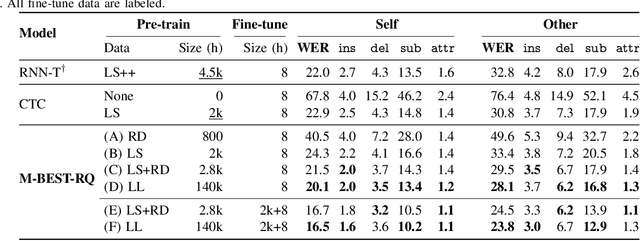
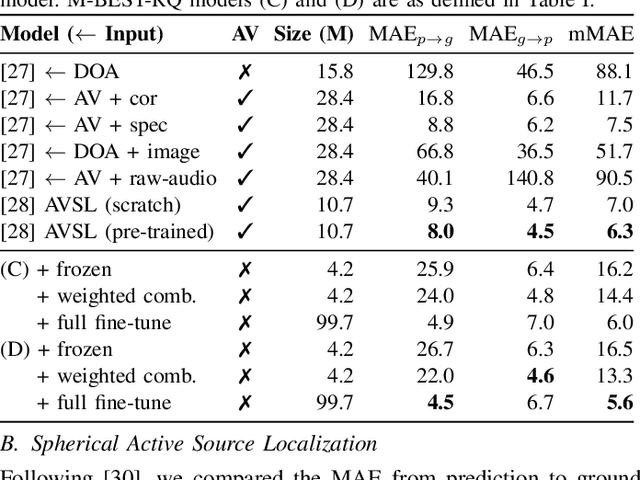
Abstract:The growing popularity of multi-channel wearable devices, such as smart glasses, has led to a surge of applications such as targeted speech recognition and enhanced hearing. However, current approaches to solve these tasks use independently trained models, which may not benefit from large amounts of unlabeled data. In this paper, we propose M-BEST-RQ, the first multi-channel speech foundation model for smart glasses, which is designed to leverage large-scale self-supervised learning (SSL) in an array-geometry agnostic approach. While prior work on multi-channel speech SSL only evaluated on simulated settings, we curate a suite of real downstream tasks to evaluate our model, namely (i) conversational automatic speech recognition (ASR), (ii) spherical active source localization, and (iii) glasses wearer voice activity detection, which are sourced from the MMCSG and EasyCom datasets. We show that a general-purpose M-BEST-RQ encoder is able to match or surpass supervised models across all tasks. For the conversational ASR task in particular, using only 8 hours of labeled speech, our model outperforms a supervised ASR baseline that is trained on 2000 hours of labeled data, which demonstrates the effectiveness of our approach.
Effective internal language model training and fusion for factorized transducer model
Apr 02, 2024


Abstract:The internal language model (ILM) of the neural transducer has been widely studied. In most prior work, it is mainly used for estimating the ILM score and is subsequently subtracted during inference to facilitate improved integration with external language models. Recently, various of factorized transducer models have been proposed, which explicitly embrace a standalone internal language model for non-blank token prediction. However, even with the adoption of factorized transducer models, limited improvement has been observed compared to shallow fusion. In this paper, we propose a novel ILM training and decoding strategy for factorized transducer models, which effectively combines the blank, acoustic and ILM scores. Our experiments show a 17% relative improvement over the standard decoding method when utilizing a well-trained ILM and the proposed decoding strategy on LibriSpeech datasets. Furthermore, when compared to a strong RNN-T baseline enhanced with external LM fusion, the proposed model yields a 5.5% relative improvement on general-sets and an 8.9% WER reduction for rare words. The proposed model can achieve superior performance without relying on external language models, rendering it highly efficient for production use-cases. To further improve the performance, we propose a novel and memory-efficient ILM-fusion-aware minimum word error rate (MWER) training method which improves ILM integration significantly.
AGADIR: Towards Array-Geometry Agnostic Directional Speech Recognition
Jan 18, 2024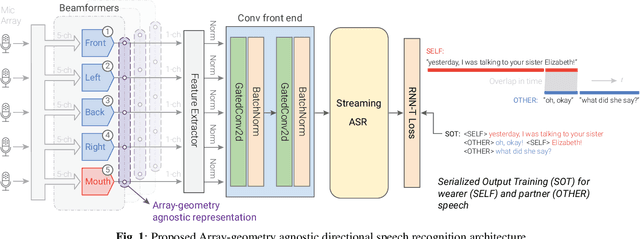

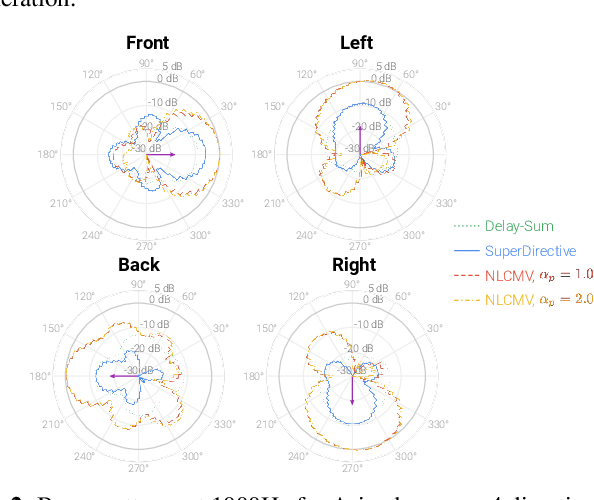

Abstract:Wearable devices like smart glasses are approaching the compute capability to seamlessly generate real-time closed captions for live conversations. We build on our recently introduced directional Automatic Speech Recognition (ASR) for smart glasses that have microphone arrays, which fuses multi-channel ASR with serialized output training, for wearer/conversation-partner disambiguation as well as suppression of cross-talk speech from non-target directions and noise. When ASR work is part of a broader system-development process, one may be faced with changes to microphone geometries as system development progresses. This paper aims to make multi-channel ASR insensitive to limited variations of microphone-array geometry. We show that a model trained on multiple similar geometries is largely agnostic and generalizes well to new geometries, as long as they are not too different. Furthermore, training the model this way improves accuracy for seen geometries by 15 to 28\% relative. Lastly, we refine the beamforming by a novel Non-Linearly Constrained Minimum Variance criterion.
Directional Source Separation for Robust Speech Recognition on Smart Glasses
Sep 20, 2023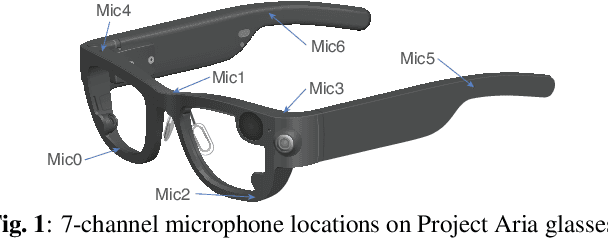

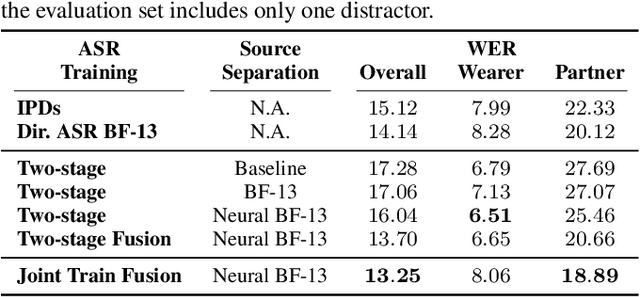
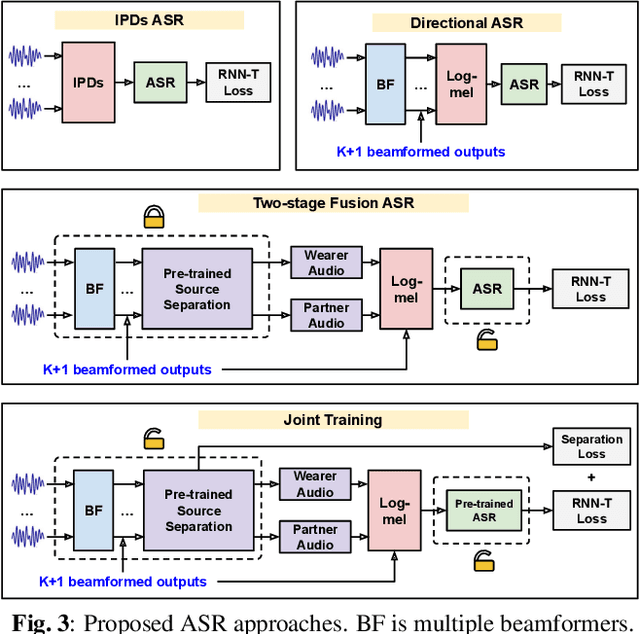
Abstract:Modern smart glasses leverage advanced audio sensing and machine learning technologies to offer real-time transcribing and captioning services, considerably enriching human experiences in daily communications. However, such systems frequently encounter challenges related to environmental noises, resulting in degradation to speech recognition and speaker change detection. To improve voice quality, this work investigates directional source separation using the multi-microphone array. We first explore multiple beamformers to assist source separation modeling by strengthening the directional properties of speech signals. In addition to relying on predetermined beamformers, we investigate neural beamforming in multi-channel source separation, demonstrating that automatic learning directional characteristics effectively improves separation quality. We further compare the ASR performance leveraging separated outputs to noisy inputs. Our results show that directional source separation benefits ASR for the wearer but not for the conversation partner. Lastly, we perform the joint training of the directional source separation and ASR model, achieving the best overall ASR performance.
SynthVSR: Scaling Up Visual Speech Recognition With Synthetic Supervision
Apr 03, 2023Abstract:Recently reported state-of-the-art results in visual speech recognition (VSR) often rely on increasingly large amounts of video data, while the publicly available transcribed video datasets are limited in size. In this paper, for the first time, we study the potential of leveraging synthetic visual data for VSR. Our method, termed SynthVSR, substantially improves the performance of VSR systems with synthetic lip movements. The key idea behind SynthVSR is to leverage a speech-driven lip animation model that generates lip movements conditioned on the input speech. The speech-driven lip animation model is trained on an unlabeled audio-visual dataset and could be further optimized towards a pre-trained VSR model when labeled videos are available. As plenty of transcribed acoustic data and face images are available, we are able to generate large-scale synthetic data using the proposed lip animation model for semi-supervised VSR training. We evaluate the performance of our approach on the largest public VSR benchmark - Lip Reading Sentences 3 (LRS3). SynthVSR achieves a WER of 43.3% with only 30 hours of real labeled data, outperforming off-the-shelf approaches using thousands of hours of video. The WER is further reduced to 27.9% when using all 438 hours of labeled data from LRS3, which is on par with the state-of-the-art self-supervised AV-HuBERT method. Furthermore, when combined with large-scale pseudo-labeled audio-visual data SynthVSR yields a new state-of-the-art VSR WER of 16.9% using publicly available data only, surpassing the recent state-of-the-art approaches trained with 29 times more non-public machine-transcribed video data (90,000 hours). Finally, we perform extensive ablation studies to understand the effect of each component in our proposed method.
Streaming Audio-Visual Speech Recognition with Alignment Regularization
Nov 03, 2022Abstract:Recognizing a word shortly after it is spoken is an important requirement for automatic speech recognition (ASR) systems in real-world scenarios. As a result, a large body of work on streaming audio-only ASR models has been presented in the literature. However, streaming audio-visual automatic speech recognition (AV-ASR) has received little attention in earlier works. In this work, we propose a streaming AV-ASR system based on a hybrid connectionist temporal classification (CTC)/attention neural network architecture. The audio and the visual encoder neural networks are both based on the conformer architecture, which is made streamable using chunk-wise self-attention (CSA) and causal convolution. Streaming recognition with a decoder neural network is realized by using the triggered attention technique, which performs time-synchronous decoding with joint CTC/attention scoring. For frame-level ASR criteria, such as CTC, a synchronized response from the audio and visual encoders is critical for a joint AV decision making process. In this work, we propose a novel alignment regularization technique that promotes synchronization of the audio and visual encoder, which in turn results in better word error rates (WERs) at all SNR levels for streaming and offline AV-ASR models. The proposed AV-ASR model achieves WERs of 2.0% and 2.6% on the Lip Reading Sentences 3 (LRS3) dataset in an offline and online setup, respectively, which both present state-of-the-art results when no external training data are used.
 Add to Chrome
Add to Chrome Add to Firefox
Add to Firefox Add to Edge
Add to Edge